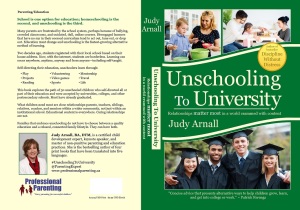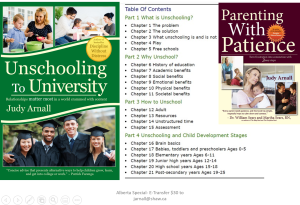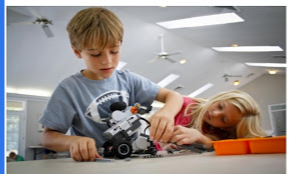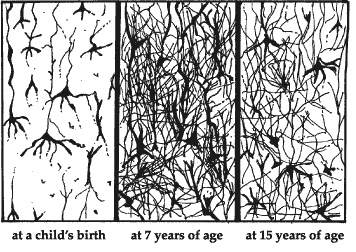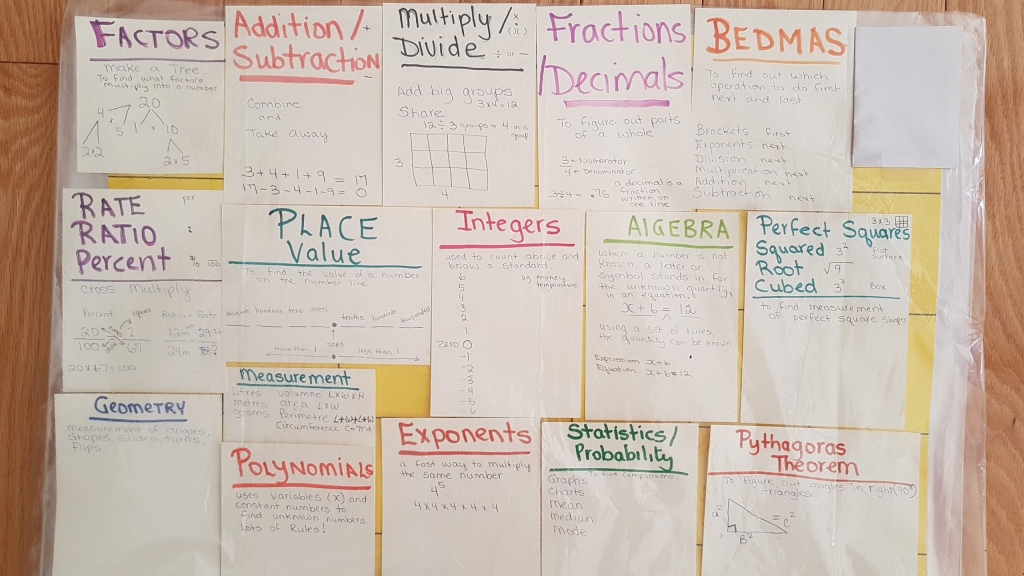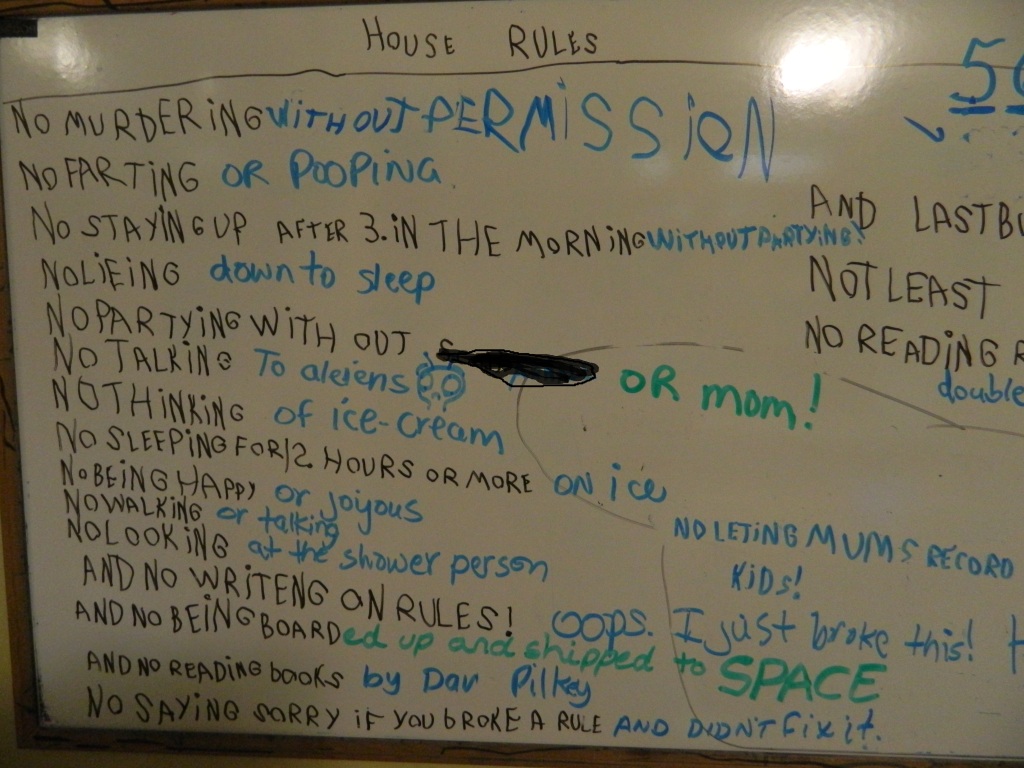Welcome to the exciting world of learning called “Unschooling.” Many people also call it “Self-Directed Education.”
Based on the book, Unschooling To University, this video encapsulates how children’s brains develop, how children learn without teaching, and why self-directed education is the most motivating and individualized education possible.
Presented by Judy Arnall, BA, CCFE, DTM, certified in brain and child development, and master of non-punitive parenting and education practices. Judy is the bestselling author of 5 print books and has unschooled 5 adult children. 3 children have graduated university, 1 is presently attending and 1 is a Masters student.
The book, Unschooling To University, is now available at bookstores everywhere including Chapters, Indigo, and Barnes and Noble. If your local bookstore or library doesn’t carry it, just ask for it.
ISBN Print 97809780509-93
ISBN E-Book 97817751786-06
This book explores the journey of the Team of Thirty, a group of young individuals (and are either friends of ours or children of friends) who unschooled anywhere from 3 to 12 years each and were accepted or graduated at university, colleges, and technical schools. 10 went into STEM fields (4 into engineering), 10 into humanities and 10 into the arts. 22 have already graduated. 2 have gone on to Masters degrees. Learn more about what unschooling is, why it is beneficial (61 benefits of unschooling), how to unschool and how unschooling fits with brain and child development stages. This 384 page book outlines everything one needs to know about unschooling and self-directed education worldwide.
#unschoolingSTEM
Did you know there is a world-wide facebook group for Unschooling STEM?
______________________________________
Second Print Run Celebration
It’s our second print run! To celebrate this momentous occasion, we are offering a great deal! Send $30 e-transfer to jarnall@shaw.ca (no password needed) and you will receive a copy of Unschooling To University and a bonus copy of Parenting With Patience, both signed by the author! And free shipping in North America! Please don’t forget to send us your address!
_________________________________________
Many unschoolers/self-directed learners often get asked the second most common question in home education, (after the one about socialization) which is “What about university? Aren’t you messing up your child’s chances of eligibility?” This blog’s sole purpose is to assure you that unschooled children can go to college, universities, trade schools or the post-secondary school of their choice, if they choose to go. And many do go on to STEM careers. When the time is right for them, they will often choose self-directed education to help themselves earn the requirements for admission acceptance.
Most parents can teach their children without curriculum until a grade 8 level. They just need to regain their parenting confidence after 150 years of schooling giving society the message that only teachers teach. Parents are the first teachers and self-learners are the best teachers. If parents don’t want to teach, they can let go and watch their children soar with curiosity, learning, problem-solving, and critical thinking at all ages.
Believe me, my “math skills” end at grade 8 and I had 3 kids get accepted into STEM programs at university. Parents do not need high school subject matter expertise. They just need to be present when their child needs them, and help the child find the resources if asked. Parents help the child self-direct their education by facilitating what they need, not teaching the program. Most unschooled children reach an age that they wish to learn more and seek out tutors, online courses or simply teach themselves from the internet, Kahn Academy, and their jurisdiction’s textbooks. Whether they learn the entire high school program, or just the final year courses to prove previously acquired learning, or even challenge the leaving or entrance (SAT) exams, children that are motivated are serious, focused learners and nothing will stop them.
As Dr. Peter Gray outlines in his 2013 study of 75 grown homeschoolers, those children with the least number of formal schooling years (either in a classroom or homeschooled), were more likely to go on to post-secondary learning. That has been our experience in the homeschooling community as well. The more time children had for play and self-directed learning, the more likely they were to continue learning and became motivated for greater stimulation outside the family. They were eager to self-teach high school content and were excited to go into post-secondary learning, at a time when many of their school friends were burned out from 16 years (12 grades and 4 years preschool) of institutionalized education.
The other myth is that unschoolers tend to choose more arts and humanities fields when applying to post-secondary institutions. STEM options are also available to unschoolers. Many unschoolers find that the years of experiential learning from play, projects and travel help round out a solid background of understanding that numbers and formulas can build on when the child reaches their teens and acquires their abstract thinking skills from the development of the brain’s pre-frontal cortex. They have real world applications for problem-solving with math and science tools. As they entered their teen years, they were more curious to learn about STEM from textbooks and online videos.
We know that not everyone aspires to go to post-secondary schools, and that is fine. Many unschooled children start businesses, do research, learn trades, and master the arts as adults. Most unschooled children are very successful because they are happy. They are doing what they love to do.
Some families want their unschooled children to have a university education. We aim to help them navigate the transition from unschooling during the “school-age” years to a more formal learning environment during the late teen and early adult years.
Many of these insights come from our family of 5 children, in which we unschooled (self-directed education) the children anywhere from 8 to 12 years that they would have been in school. We had many family friends that also unschooled and I tell their experiences (The Team of Thirty) in the Unschooling To University book. 10 of the 30 children profiled, attended university in STEM careers. Some went the high school (and self-designed) diploma route and some did not.
We are not outliers. The gates to education are still there but the walls are coming down. We now know that anyone can study anything, anywhere, anytime, and any way. School is only one method of many in obtaining an education. We hope you enjoy our experiences, thoughts and insights to help you make informed education choices. We also welcome your questions. Yes, unschooled children can go on to post-secondary education and they are excellent learners, free thinkers, employed and enjoy life. We need thought leaders and world problem-solvers, but more than that, we need happy, contented, educated citizens of the world .
Many of these blogs posts are excerpts from the book but many posts are new insights from unschooling 5 productive and educated adults. Welcome to this blog and inside our home-life!
-Judy
#unschooling #homeschooling #unschoolingSTEM #unschoolingtouniversity

